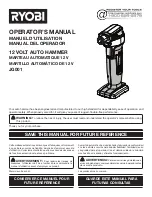
14 Gauge Electric Metal Shear
12
For technical questions call: 1-800-665-8685
8083115
V 2.1
ADJUSTING THE UPPER SHEAR BLADE
1. The upper shear blade (no. 12) has adjusting screws (no. 8) and screws (no. 6) that are used to adjust the
blade’s position. Loosen the screw with a wrench.
2. Loosen and hold the lock nut (no. 7) with a box wrench (not included).
3. The adjusting screw can now be adjusted. The upper shear blade should be adjusted for different material
types and thicknesses.
4. Ensure that the blades will operate properly before use. The tool should always be tested on scrap material
before use on final work material.
5. When sharpening the blades, maintain the original dimensions of a 12° angle on the upper shear blade with
an 8° angle across its thickness.
6. When sharpening the blades, maintain a 4° angle on the butt of the lower shear blade.
NOTE: When working with sheet steel, the formula for adjusting the upper shear blade is Gap = steel thickness
divided by 5.
NOTE: The gap should be slightly smaller for rubbery or soft materials and slightly larger for hard materials.
REPLACING CARBON BRUSHES
After extended use, your electric metal shear may not run as smoothly. If it starts or runs slowly, makes a grinding
noise or will not run at all, the problem may be worn carbon brushes. To replace the carbon brushes:
1. Unplug the tool before beginning maintenance.
2. To examine the condition of the brushes, unscrew each brush cap and remove each brush.
NOTE: Record the position of each carbon brush as you remove it, so you can replace them in exactly the
same way. Carbon brushes wear into the armature. If they are replaced in a different orientation, they will have
to undergo additional wear before they will fit properly again.
Problem(s)
Suggested Solution(s)
Carbon brushes are severely worn (less
than 1/8 in. of carbon remaining)
Replace carbon brushes.
Either brush is cracked or chipped
Replace both brushes.
Carbon brushes are glazed
Remove the glaze with a pencil eraser and reuse the brushes.
Ensure that they are replaced in the same configuration that they
were removed.
Carbon brushes are in good condition with
more than 1/8 in. of carbon remaining
Replace the original brushes in the same configuration that they
were removed.
3. When replacing a carbon brush, insert it into the brush holder carbon end first, with the spring end
to the outside.
4. Replace the brush cap and tighten it by turning it clockwise.
NOTE:
When replacing carbon brushes, always replace both brushes at the same time.
5. After replacing the carbon brushes, let the tool run for 2 minutes before use. This will allow the carbon
brushes to wear into the armature.













































